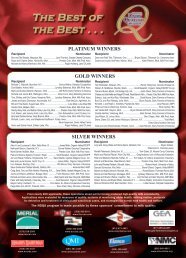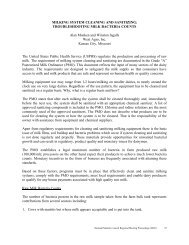DECIDING TO DRY,OFF - National Mastitis Council
DECIDING TO DRY,OFF - National Mastitis Council
DECIDING TO DRY,OFF - National Mastitis Council
You also want an ePaper? Increase the reach of your titles
YUMPU automatically turns print PDFs into web optimized ePapers that Google loves.
antibiotic treatment (10,11), protecting teat ends from bacterial contamination (13,30),<br />
manipulation of udder involution (26), and vaccination with gram negative core antigens (14).<br />
However, all of these methods are not implemented until after the last milking. The effect of<br />
management factors that take place within the two weeks prior to scheduled drying off are<br />
precluded in any definition in which the dry period begins only when milking stops.<br />
In 1950, when the early dry period was first identified as a significant period of risk for new<br />
IMI (19), the investigators differentiated a “dry period” from the “true dry period”. The “dry<br />
period” was defined as the 14 days before last milking until the 14 days after calving, whereas<br />
the “true dry period” was only the time during which the cow was not being milked. Having<br />
made such a distinction, specific attention could be focused on determining if the method of<br />
drying off had an influence on the development of IMI during the dry period (18,27).<br />
The difference between abrupt or intermittent cessation of milking, and the influence of a<br />
change in ration during this time period have been investigated (27). Based on data from two<br />
research herds, it was concluded that the method of milk cessation could affect the rate of IMI<br />
during the dry period, but that additional studies using other herds and different patterns of<br />
infection would be required. In spite of this work, other than the use of blanket dry cow<br />
antibiotic therapy, there is no clear recommendation available on the best method to dry off<br />
cows. Specific guidelines to manage cows from two weeks before until two weeks after drying<br />
off are noticeably absent from scientific and lay literature. The <strong>National</strong> <strong>Mastitis</strong> <strong>Council</strong><br />
(NMC) does make a specific recommendation for drying off. The NMC recommends: “High<br />
producing cows should be taken off concentrate feeding two weeks before anticipated dry off.<br />
A change in environment can also help reduce production. When all quarters of cows are dry<br />
treated after the last milking, abrupt cessation of milking is recommended…”(16). However,<br />
the source data for this recommendation is not presented. Therefore, the objective of this paper<br />
is to review the published literature pertaining to drying off, and to identify important gaps in<br />
our knowledge. In particular, the importance of the level of milk production at drying off and<br />
its relationship to the development of new IMI’s will be considered. The overall aim is to<br />
identify specific management practices that can be manipulated to reduce the risk of new<br />
intramammary infections at the time of drying off and in the early dry period.<br />
Method of Milk Cessation<br />
Different methods to stop milk production at the end of lactation have been studied. The two<br />
most common methods are to abruptly stop milking and to intermittently milk the cow on a<br />
particular schedule leading up to the final milking. In both cases, herd specific drying off<br />
practices, including dry cow antibiotic therapy, are administered immediately after the last<br />
milking. It is important to realize that the definition of “intermittent” varies across studies, and<br />
is not synonymous with one approach. Intermittent may refer to once a day milking every other<br />
day for the week prior to drying off, or it may mean milking once a day during the week prior,<br />
with the cow not being milked the day before drying off. Abrupt cessation of milking implies<br />
that milking proceeds as usual, irrespective of scheduled drying off, and simply stops when the<br />
cow is to go dry. Crucial to the debate over the benefit of either method, is to resolve the<br />
importance of the level of milk production at dry off. Although specific reasons for the<br />
70 <strong>National</strong> <strong>Mastitis</strong> <strong>Council</strong> Annual Meeting Proceedings (2001)





